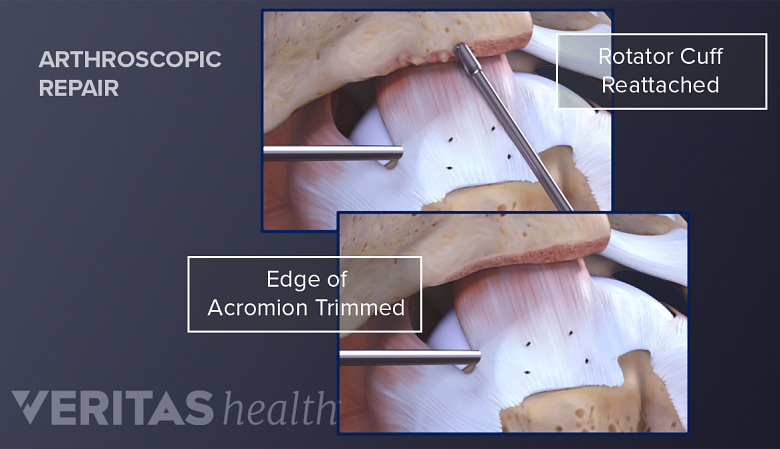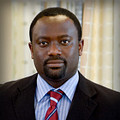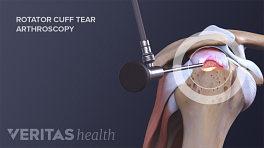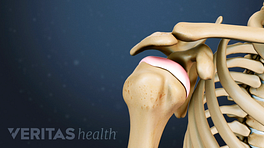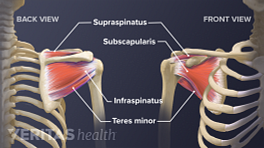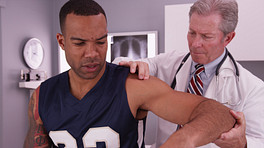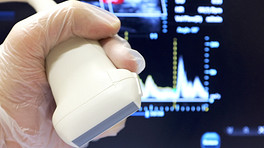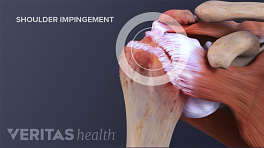A doctor might recommend a surgery called subacromial [sub-ah-kro-mee-al] decompression if shoulder impingement pain does not go away with rest and physical therapy.
See Surgical Treatment Options for Shoulder Impingement
Shoulder impingement occurs when certain movements put excessive pressure on the shoulder’s soft tissues. For example, raising an arm can cause the rotator cuff to be pinched. Decompression surgery relieves this pressure by expanding the available space for soft tissue.
In This Article:
- Decompression Surgery for Shoulder Impingement
- Shoulder Decompression: Arthroscopy vs Open Surgery
- Shoulder Decompression Surgery: Recovery, Risks, and Complications
What Happens During the Procedure?
Decompression surgery relieves shoulder impingement by trimming the acromion bone.
During decompression surgery, a surgeon removes bone tissue to increase the subacromial space, which is located between the shoulder’s ball-and-socket and the bone above it, called the acromion. In a normal shoulder the subacromial space is about 9 to 10 millimeters high. 1 Petersson CJ, Redlund-johnell I. The subacromial space in normal shoulder radiographs. Acta Orthop Scand. 1984;55(1):57-8. If this space shrinks just a few millimeters, the rotator cuff and subacromial bursa can become squeezed and a person might feel shoulder impingement symptoms.
Decompression surgery can involve one or both of these procedures:
- Shaving down the acromion bone in a process called acromioplasty [ah-kro-mee-o-plas-ty]. Shaving down the underside of the acromion relieves shoulder impingement symptoms by reducing pressure on the rotator cuff and bursa.
- Removing bone spurs (called osteophytes) that have developed on the shoulder’s bones. These bone spurs can rub uncomfortably against the rotator cuff and/or the subacromial bursa.
Rotator cuff tears may also be repaired during a subacromial decompression procedure.
Removal of the Coracoacromial Ligament
Some surgeons think the removal of a ligament at the top of the shoulder, called the coracoacromial ligament, provides better surgical results, while others think removal has a negative effect on long-term shoulder stability.
Traditionally, most surgeons who performed shoulder decompression surgery removed the coracoacromial ligament. The ligament blocks the surgeon’s access to the acromion and can make the surgery technically challenging.
However, the coracoacromial ligament is now recognized for its role helping to stabilize the shoulder joint, 2 Lee TQ, Black AD, Tibone JE, McMahon PJ. Release of the coracoacromial ligament can lead to glenohumeral laxity: A biomechanical study. Journal of Shoulder Elbow Surgery. 2001; 10: 68-72. As cited in Matsen FA, Arntz CT. Rotator Cuff. In Rockwood CA, Matsen FA, Michael AW, Harryman DT, editors. The shoulder 2nd ed. Philadelphia: WB Saunders; 1999. 755-839. and whether or not it should be removed during surgery is a topic of debate.
Nonsurgical Treatment is Recommended First
Physicians frequently recommend at least 3 to 4 months of nonsurgical treatment, such as stretches and strengthening exercises and/or a subacromial injection, before considering decompression surgery. Research suggests that patients who give nonsurgical treatments worthwhile effort may avoid surgery and have similar outcomes to patients who choose surgery as their first treatment. 3 De Yan Tien J, Hwee Chye Tan A. Shoulder Impingement Syndrome, A Common Affliction of the Shoulder: A Comprehensive Review. Department of Orthopaedic Surgery, Singapore General Hospital, Singapore. 2014; 23: 297-305
- 1 Petersson CJ, Redlund-johnell I. The subacromial space in normal shoulder radiographs. Acta Orthop Scand. 1984;55(1):57-8.
- 2 Lee TQ, Black AD, Tibone JE, McMahon PJ. Release of the coracoacromial ligament can lead to glenohumeral laxity: A biomechanical study. Journal of Shoulder Elbow Surgery. 2001; 10: 68-72. As cited in Matsen FA, Arntz CT. Rotator Cuff. In Rockwood CA, Matsen FA, Michael AW, Harryman DT, editors. The shoulder 2nd ed. Philadelphia: WB Saunders; 1999. 755-839.
- 3 De Yan Tien J, Hwee Chye Tan A. Shoulder Impingement Syndrome, A Common Affliction of the Shoulder: A Comprehensive Review. Department of Orthopaedic Surgery, Singapore General Hospital, Singapore. 2014; 23: 297-305
